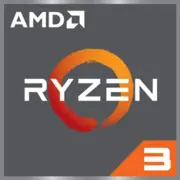AMD Ryzen 3 5300G

AMD Ryzen 3 5300G: Budget APU for Office Use, Multimedia, and Light Gaming
Relevant as of April 2025
Key Specifications: Zen 3, 7nm, and Integrated Graphics
The AMD Ryzen 3 5300G processor, released in 2021, remains a popular choice for budget builds due to its successful combination of price and performance.
Architecture and Technology Process
- Codename: Cezanne (Zen 3).
- Technology Process: 7nm (TSMC).
- Cores/Threads: 4/8.
- Frequencies: 4.0 GHz (base), 4.2 GHz (turbo).
- Cache: L3 — 8 MB.
- TDP: 65W.
- Integrated Graphics: Radeon Vega 6 (6 cores, up to 1700 MHz).
The processor is built on the Zen 3 architecture, which provides a 19% IPC (instructions per clock) increase compared to Zen 2. This makes it efficient in tasks that require fast data processing, such as office applications or browsing with dozens of tabs open.
Key Features:
- Supports PCIe 3.0 (16 lanes).
- Technologies include Precision Boost 2 and SMT (Simultaneous Multithreading).
- Integrated Vega 6 graphics that can handle gaming at 720p–1080p on low settings.
Performance:
- Geekbench 6: 1611 (single-core), 5363 (multi-core).
- In Cinebench R23 tests: ~1100 points (single-threaded), ~5500 (multi-threaded).
- Practical example: rendering a 10-minute video in DaVinci Resolve takes about 25–30 minutes.
Compatible Motherboards: AM4 Socket and Chipsets
The Ryzen 3 5300G uses the AM4 socket, allowing for savings on the motherboard. Suitable chipsets include:
- B550: the optimal choice (supports PCIe 4.0, overclocking). Examples: ASUS TUF B550-Plus ($120–$150).
- A520: a budget option without overclocking (Gigabyte A520M DS3H — $70–$90).
- X570: excessive for this CPU but suitable for upgrades (MSI MPG X570 Gaming Plus — $160+).
Important:
- For motherboards with B450/X470 chipsets, a BIOS update may be required.
- As of 2025, AM4 is an aging platform. If planning to upgrade to Ryzen 7000/8000, it's better to consider AM5.
Memory: DDR4-3200 and Dual-Channel Mode
The processor supports DDR4 with a maximum frequency of 3200 MHz (non-overclocked). Recommendations:
- Use two modules to enable dual-channel mode (for example, 2×8 GB).
- Optimal models: Corsair Vengeance LPX DDR4-3200 ($40–$50 for 16 GB), Crucial Ballistix ($45–$55).
- Real tests show a performance increase of up to 15% in games when upgrading from DDR4-2400 to DDR4-3200.
Note: DDR5 and LPDDR5 are not supported.
Power Supply: 450W is Sufficient
With a TDP of 65W, the Ryzen 3 5300G does not require a powerful PSU:
- For a system without a discrete graphics card: a PSU of 300–350W is sufficient (for example, be quiet! Pure Power 11 350W — $55).
- With a graphics card like the NVIDIA GTX 1650 or RX 6400: 450–500W (EVGA 500 BR — $60, Corsair CX450 — $65).
- Always choose units with 80 Plus Bronze certification or higher.
Pros and Cons of the Ryzen 3 5300G
Pros:
- Low power consumption and heat output.
- Integrated graphics for light gaming (CS2, Fortnite, GTA V on medium settings).
- Affordable price ($110–$130 in 2025).
Cons:
- Only 4 cores — limited multitasking capabilities.
- Lacks PCIe 4.0 and DDR5 support.
- Outdated AM4 socket (difficult upgrades without changing the motherboard).
Use Cases
1. Office and Study:
- Working with documents, video conferencing, browsing with 20+ tabs.
- Example: a build based on 5300G + 16 GB DDR4 + 512 GB SSD — ideal for remote work.
2. Multimedia:
- 4K video playback in VLC or Kodi runs smoothly thanks to hardware decoding.
3. Gaming:
- Integrated Vega 6: 30–45 FPS in Dota 2 (1080p), 40–50 FPS in Minecraft.
- With a discrete graphics card (e.g., RX 6600): 60 FPS in Cyberpunk 2077 (1080p, medium settings).
4. Home Server:
- Low power consumption allows the CPU to be used in NAS or media server setups.
Comparison with Competitors
- Intel Core i3-13100F ($115–$130):
- Better in single-threaded tasks (Geekbench 6 Single-Core ~1800), but lacks integrated graphics.
- Requires a graphics card for gaming.
- AMD Ryzen 5 5600G ($160–$180):
- 6 cores/12 threads and Vega 7. 30–40% more powerful but more expensive.
- Intel Core i5-12400 ($180):
- Higher performance in multi-threaded tasks but a higher price.
Conclusion: The Ryzen 3 5300G outperforms competitors primarily due to its integrated graphics.
Building Tips
1. Motherboard: Choose B550 for PCIe 4.0 (if planning on NVMe SSD).
2. Cooling: The stock cooler is sufficient, but for quieter operation — Arctic Freezer 34 ($30).
3. Storage: SSD is a must (e.g., WD Blue SN570 500 GB — $45).
4. Case: Micro-ATX with good ventilation (Deepcool MATREXX 40 — $50).
Final Thoughts: Who is the Ryzen 3 5300G For?
This processor is an ideal choice for:
- Budget PCs: When needing to build a system for under $400.
- Office Tasks and Study: Reliability and low power consumption.
- Media Centers: 4K video playback and streaming.
- Beginner Gamers: For gaming at lower settings without investing in a graphics card.
Why this choice? In 2025, the Ryzen 3 5300G remains one of the few APUs with a balance of price and functionality. If you don’t need 8 cores or PCIe 5.0, this processor offers smart savings without serious compromises.
Basic
CPU Specifications
Memory Specifications
GPU Specifications
Benchmarks
Compared to Other CPU
Share in social media
Or Link To Us
<a href="https://cputronic.com/en/cpu/amd-ryzen-3-5300g" target="_blank">AMD Ryzen 3 5300G</a>